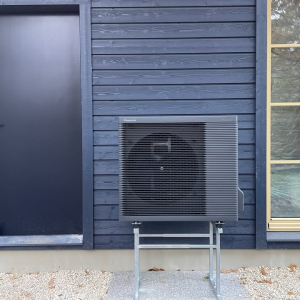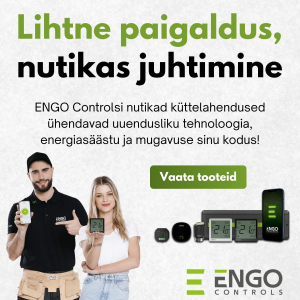Solar heating is becoming increasingly popular
In recent years, the prices of electricity, gas, and heating oil have multiplied. Local heating materials such as wood, peat, and oil shale have also become more expensive. Solar heating is a free and clean green energy that is not dependent on energy prices in the market. More economical people have started to look for alternative heat energy production methods in addition to primary heating fuels. One of the cheapest options, which we also offer, is solar heating - converting solar energy into heat.
Solar Heating vs Other Heating Types
When comparing the cost per kWh of heat energy obtained from a solar heating system with other energy sources like ground heating, ion heating (electrode boiler), gas, or light oil heating, which are offered as convenient types of heat energy, it can be confidently stated that when combined with wood gas or pellet heating systems like Atmos, the investment is significantly more rational, and the cost of heat energy is considerably lower than with the aforementioned energy sources.
Moreover, during operation, the solar heating system requires only minimal electricity consumption for the circulation pump, just a few watts. For example, the electricity consumption for maintaining a ground heating system constitutes about 20-30% of the heat energy obtained, not to mention the high construction costs. In the case of ion heating, the cost of the heat energy obtained from the device is equal to the cost of electricity per kWh. One kWh of electricity can only produce approximately one kWh of heat energy. The price of heating oil increases every year and may disappear as a boiler fuel in the future. In the near future, oil will be used only for transportation needs.
Modern solar panels or collectors have an efficiency rate of 90-95% at ideal moments. An ideal moment is considered when the sun's rays are not obstructed by clouds and are as perpendicular as possible to the surface of the solar panel or collector. Achieving such a level is, of course, practically very difficult and expensive, so we base our calculations on an average level where solar heating already pays off. From March onwards, the sun heats the antifreeze circulating in the solar panel, and the obtained heat energy is stored through a heat exchanger in a thermal storage tank (accumulation tank) or directly into a specific type of hot water boiler.
It is more beneficial to heat both the hot water boiler and the house's heating system from a system with a thermal storage tank. When the sun's impact is minimal or there is no solar radiation on cloudy days, the boiler and other heat consumers are heated with the heat energy stored in the thermal storage tank. Solar panels can capture solar radiation to some extent even through thinner clouds, significantly compensating for heat energy losses.
Components of a Solar Heating System
For a house with an area of 100-150 m², it is recommended to install solar panels with a total area of 12-20 m². A large thermal storage tank allows for the use of a higher capacity solar panel system, so more heat energy can be stored on sunny days and used when the sun is not shining. How many solar panels to use depends on the volume of the thermal storage tank. For example, one solar panel is sufficient to fully heat a 150-200 liter three-system hot water boiler on a sunny day. If a three-system hot water boiler is used, it operates on electricity on cloudy days.
A solar heating system consists of a solar panel, an automation block, a pump unit, an expansion tank, and connecting pipes. The solar panel is filled year-round with antifreeze. The most effective solar heating system would be one where the primary heating system already has a large capacity thermal storage tank. In this case, only a heat exchanger needs to be installed in the lower part of the tank.
When installing solar panels concerning the sun's movement, they can be better adjusted with appropriate mounting details if the roof directions and slopes of the house are not the most suitable. Panels can also be installed on the ground if there is space and no risk of damage. In early spring and autumn, the Earth's angle of rotation relative to the sun changes significantly, and during this time, less heat energy is obtained from the sun, but it is still possible, and besides, it is free. With sunny weather and a good solar panel arrangement, it is possible to maximize the capture of solar heat throughout the sunny day.
A Functional Solar Heating Solution
In 2006, six flat solar panels were installed on a house, and every year since then, it has saved almost half of the previously spent costs on other energy (electricity and wood for the boiler) for hot water preparation. Thanks to the solar heating system, this house received very cheap solar energy for seven months. During this period, the boiler had to be fired only two or three times when the sun was covered by thick rain clouds for 5-6 days and the hot water ran out.
Specifically, this house is heated in winter by a wood gas boiler Atmos, and a 2.5 m³ thermal storage tank is installed. The same system heats the shower room and its anteroom, as well as the floors of the corridor and kitchen. On sunny days, about 90% of the heat energy is obtained only from the sun. During half the year, with an average number of sunny days, the payback time for such a system is considerably shorter than for a ground heating system.
The payback period for expenses incurred in building a solar heating system depends on the amount of hot water used, the number of heated shower rooms or other damp rooms' floors, and the quantity of other heated components (pool water). The more solar-heated water is used, the faster the solar heating system pays for itself. The cost of such a system depends on the existing heating system solution of each house, the type of solar panels, and the customer's preferences, as well as the direction of panel installation relative to the sun.
Which Solar Panels to Choose?
We offer two types of solar panels:
Flat Solar Panels or Collectors: Underneath the radiation-absorbing glass, there is a heat exchanger made of copper pipes in which antifreeze circulates as the heat carrier. The toughened cover glass is shatter-resistant and transparent to solar radiation. Thermal insulation limits heat loss and increases efficiency.
Vacuum Tube Solar Panels or Collectors: The heat exchanger made of copper pipes is located in vacuum tubes, where antifreeze also circulates. The outer surface of the inner tube is coated with a selective absorbing layer. The collected energy is conducted to the liquid in the copper tube via a special lamella. Due to the tubular shape of the absorbing surface, the effective working area is maintained even as the sun moves.
The advantage of vacuum tube solar panels is their high solar radiation absorption and low impact from the external environment's low temperature and wind. Vacuum tube solar panels function partially even in diffuse cloudiness.
In principle, a vacuum tube is like a glass coffee thermos, but instead of a silver layer, the inner glass tube is covered with a heat-absorbing black (like mirrored smoke glass) layer, which has the property of attracting solar radiation and converting it into heat. The internal temperature can reach up to 300 degrees, but the outside of the tube is as cool as the surrounding environment.
Flat solar panels are slightly more sensitive to the cooling effect of the external environment.





